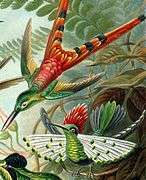Red-tailed comet
| Red-tailed comet | |
|---|---|
| | |
| A male Red-tailed Comet in Cordoba, Argentina. | |
| Scientific classification | |
| Kingdom: | Animalia |
| Phylum: | Chordata |
| Class: | Aves |
| Order: | Trochiliformes |
| Family: | Trochilidae |
| Genus: | Sappho L. Reichenbach, 1849 |
| Species: | S. sparganurus |
| Binomial name | |
| Sappho sparganurus (Shaw, 1812) | |
| Synonyms | |
|
Sappho sparganura | |
The red-tailed comet (Sappho sparganurus) is a medium-sized hummingbird belonging to the family Trochilidae.
Etymology and local names
The genus name refers to Sappho, an ancient Greek poet of Lesbos. The species name sparganus derives from the Greek words σπαργανόω and ουρά, meaning "decorated tail".[2]
In at least part of its range it is known in the local Quechua language as Q'ori Kenti ("golden hummingbird"). It is called the picaflor cometa in Spanish.
Subspecies
Subspecies include:
- Sappho sparganurus sparganurus – northern and central Bolivia, occasionally in southern Peru
- Sappho sparganurus sapho – from southern Bolivia to western Argentina and northern Chile
Distribution

This species can be found in the central Andes of Bolivia and Argentina, in Chile and in Peru.[1][3]
Habitat
Common to frequent in the woodlands and scrub typical of the dry Interandean valles extended up into Polylepis forests, and into the shrubby transition zones to high elevation puna or the moister cloud forests. These hummingbirds live in arid scrub with cacti and Prosopis trees and in deciduous forests with Alnus and Podocarpus.[4] It is frequently found around human habitation in agricultural areas, cities and towns.
Description
Sappho sparganurus is one of the largest hummingbirds, and males reaching a length of 22 cm, females up to 15 cm. The plumage of males is largely green, with a shining gorget. The head is green, while the back and rump are reddish violet. The male has a deeply forked, spectacular, long, iridescent, golden-reddish tail, longer than the length of the body, while the female has a shorter reddish-bronze tail.[5][6][7] The species has a hoarse chattery call.[4]
Gallery
 Illustration from Kunstformen der Natur (1904)
Illustration from Kunstformen der Natur (1904)- Sappho sparganurus. Museum specimen
 Museum specimen
Museum specimen- Museum specimen
Bibliography
- del Hoyo, J., Collar, N.J., Christie, D.A., Elliott, A. and Fishpool, L.D.C. 2014. HBW and BirdLife International Illustrated Checklist of the Birds of the World. Lynx Edicions BirdLife International.
- George Shaw: General Zoology, or systematic natural history. With plates from the first authorities and most select specimens, engraved principally by Mrs. Griffith. Bd. 8, Nr. 1. Thomas Davison, London 1812
- James A. Jobling: Helm Dictionary of Scientific Bird Names. Christopher Helm, London 2010, ISBN 978-1-4081-2501-4.
- Javier González Zapata: Sobre la presencia en Chile de Sappho sparganura sappho (Lesson) (Aves: Trochilidae). In: Boletín Ornitológico. Bd. 9, Nr. 1/2, 1977, S. 10–11
- Jon Fjeldså, Niels Krabbe: Birds of the High Andes: A Manual to the Birds of the Temperate Zone of the Andes and Patagonia, South America. Apollo Books, Stenstrup 1990, ISBN 87-88757-16-1.
- René Primevère Lesson: Manuel d'ornithologie, ou Description des genres et des principales espèces d'oiseaux. Bd. 2. Roret, Paris 1828.
References
- 1 2 BirdLife International (2012). "Sappho sparganura". IUCN Red List of Threatened Species. Version 2013.2. International Union for Conservation of Nature. Retrieved 26 November 2013.
- ↑ Jobling, James A. (2010). Helm Dictionary of Scientific Bird Names. London: Christopher Helm. ISBN 978-1-4081-2501-4.
- ↑ Bird Life International (2016). "Red-tailed Comet Sappho sparganurus". Retrieved 10 November 2016.
- 1 2 "Red-tailed Comet Sappho sparganurus (Shaw, 1812)". Xeno-canto. Retrieved 8 November 2016.
- ↑ The Penny Cyclopædia of the Society for the Diffusion of Useful Knowledge. 25. London: Charles Knight and Co. 1863. p. 281. Retrieved 10 November 2016.
- ↑ Shaw, George (1812). General Zoology, or Systematic Natural History Volume VIII, Part 1: Aves. London: Kearsley et al. p. 291. Retrieved 10 November 2016.
- ↑ Schulenberg, Thomas S.; Jaramillo, Alvaro (2015). Schulenberg, T. S., ed. "Red-tailed Comet (Sappho sparganurus)". Neotropical Birds Online. Ithaca: Cornell Laboratory of Ornithology. Retrieved 10 November 2016.
| Wikimedia Commons has media related to Sappho sparganura. |
